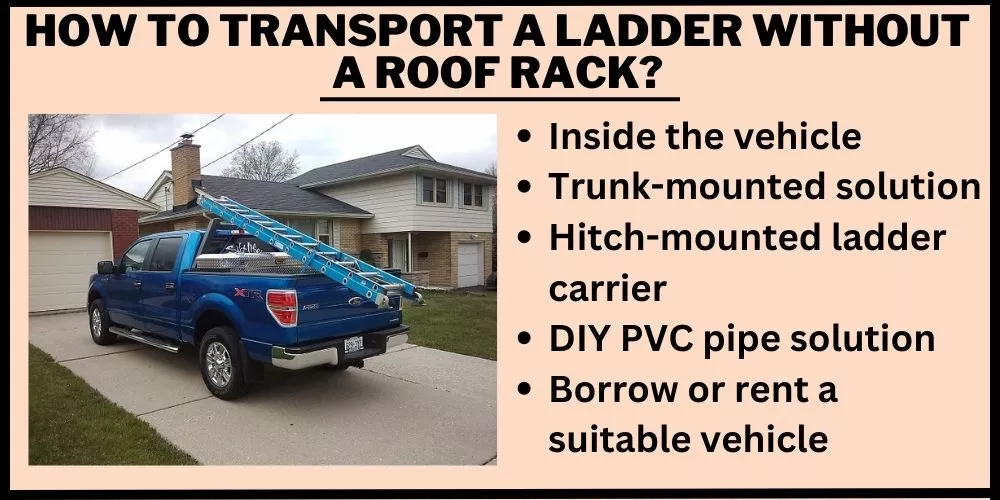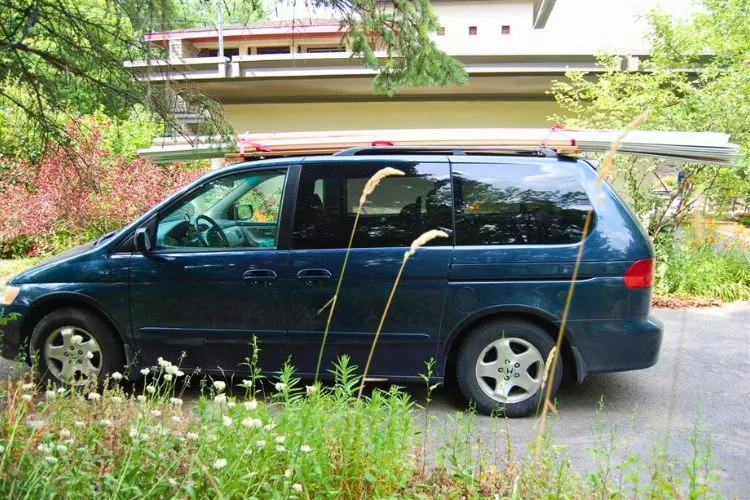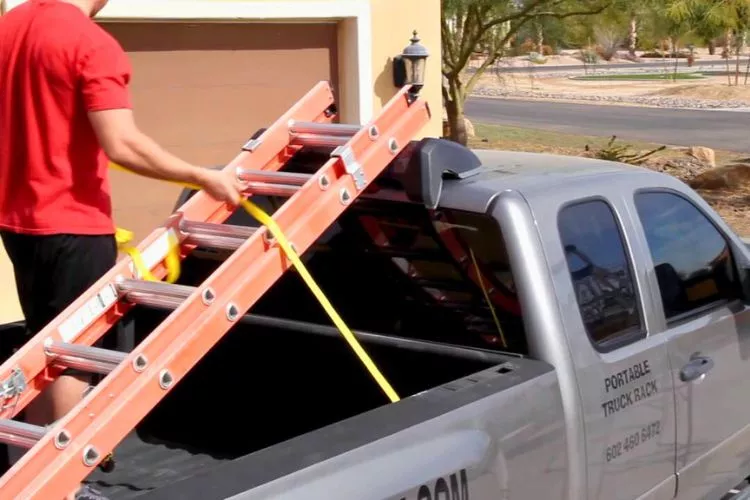Mastering the knowledge of how to transport a ladder without a roof rack might seem daunting, but with a little ingenuity, you’ll find several viable alternatives.
In this article, we’ll explore five ways to safely and securely transport your ladder without the need for a roof rack.

How to transport a ladder without a roof rack? (The Best Tips)
Transporting a ladder without a roof rack requires a bit of creativity and resourcefulness. Assess your vehicle’s capabilities, the size of your ladder, and your comfort with DIY solutions to determine the best method for your needs.
Remember, safety should always be your top priority, so ensure your chosen method securely holds the ladder in place during transportation.
Now, let’s learn how to transport a ladder without a roof rack in detail.

🪜 Inside the vehicle
If you have a spacious car, van, or SUV, you can transport your ladder inside the vehicle. To do this, simply fold down the rear seats and slide the ladder in, ensuring it’s properly secured to prevent it from shifting during transit.
Remember that you’ll need to measure your vehicle’s interior and the ladder beforehand to ensure it’ll fit.
🪜 Trunk-mounted solution
For sedans with a trunk, consider using trunk-mounted straps or bungee cords to secure the ladder. Open the trunk, place a protective cloth or padding on the edge, and let the ladder extend out.
Secure the ladder using straps or cords to the trunk’s latch and anchor points. Don’t forget to tie a red flag to the end of the ladder to alert other drivers.
🪜 Hitch-mounted ladder carrier
A hitch-mounted ladder carrier is an alternative to a roof rack. These carriers attach to the rear hitch of your vehicle and provide a secure platform for your ladder. Ensure that the carrier is compatible with your vehicle’s hitch and can safely handle the weight and dimensions of your ladder.
🪜 DIY PVC pipe solution
Create a makeshift ladder carrier using PVC pipes and fittings. Construct a frame that securely cradles your ladder, attaching it to your vehicle using ratchet straps or bungee cords.
Ensure the frame is sturdy and won’t damage your car’s exterior. This DIY solution requires some handy work, but it’s cost-effective if you don’t want to invest in a commercial carrier.
🪜 Borrow or rent a suitable vehicle
If none of these solutions work for you, consider renting a vehicle with a built-in roof rack or enough interior space to accommodate your ladder.
This option might not be the most convenient, but it’s a surefire way to transport your ladder without worrying about potential damage or safety concerns.
How to tie a ladder to the roof of your car without a roof rack?
It’s important to tie the ladder correctly, otherwise you’ll not be be able to safely and securely transport a ladder without a roof rack. Always double-check the ladder’s position and the tightness of the straps or ropes throughout your journey, making adjustments as needed.
What you’ll need:
- Two or three ratchet straps or strong ropes
- A blanket or padding material

- Prepare the ladder: Make sure your ladder is clean and free from any debris. If it’s a folding ladder, fold it completely and lock it in place. If it’s an extension ladder, collapse it to its smallest size.
- Prepare your car: Clean your car’s roof to remove any dirt or debris that could cause scratches. If you’re concerned about potential damage to your car’s paint job, lay a blanket, towel, or other padding material on the roof to provide a protective barrier between the ladder and the car.
- Position the ladder: With the help of a friend, lift the ladder onto the roof of your car. If using any, center it on the padding you’ve placed on your roof. Make sure the ladder is positioned in a way that doesn’t obstruct your view through the windshield or rear window.
- Secure the ladder with straps or ropes: Take your ratchet straps or ropes and thread them through the rungs of the ladder. Attach the hooks to the car’s door frames if you’re using ratchet straps. If you’re using ropes, open the car doors and thread the ropes through the car’s interior, leaving enough length on both ends to secure the ladder.
- Tighten the straps or ropes: For ratchet straps, pull the straps tight and ratchet them down until they’re secure. For ropes, tie a secure knot on one end, pull the rope tight, and tie another secure knot on the other end. Ensure the ladder is snugly attached to the car and doesn’t move around when gently shaken.
- Add additional straps or ropes for extra security (optional): If you have extra straps or ropes, you may choose to add them for additional security. Follow the same process as in steps 4 and 5, threading the straps or ropes through different rungs and attaching them to different parts of the car.
- Double-check everything: Before driving off, double-check all the straps or ropes before driving off to ensure they’re tight and secure. Ensure the ladder is still properly positioned on the roof and doesn’t obstruct your view.
- Drive with caution: When driving with a ladder on your roof, be aware of your car’s increased height and take extra care when passing under low bridges or overhangs. Drive slower than usual and avoid sudden stops, sharp turns, or maneuvers that could cause the ladder to shift or become dislodged.
How far can a ladder stick out the back of a truck?
In general, most states have laws that regulate the length of objects that can protrude from the back of a truck. These laws are in place to ensure the safety of other road users and prevent accidents.
The exact length varies from state to state, but the general rule of thumb is that the ladder should not extend more than 3 feet beyond the vehicle’s rear.

However, some states have different laws regarding the length of an object that can overhang the vehicle’s rear.
For example, in California, ladders can extend up to 4 feet beyond the vehicle’s rear, provided that the ladder’s extremities are marked with a red flag that’s at least 12 inches square.
In Texas, the ladder can extend up to 4 feet beyond the rear of the vehicle, but the ladder’s extremities must be marked with a red or fluorescent orange flag at least 18 inches square.
It’s important to note that the ladder type also determines how far it can stick out the back of a truck. For instance, extension ladders are longer and heavier than step ladders, and their length needs to be considered when transporting them.
If an extension ladder is too long, it can cause instability, making it unsafe to transport.
Frequently Asked Questions (FAQs)
u003cstrongu003eShould you carry a ladder vertically or horizontally?u003c/strongu003e
When carrying a ladder, it is recommended to carry it horizontally, with two people if possible, to ensure stability and prevent injury. Carrying a ladder vertically can be dangerous and cause the ladder to sway or bump into objects, increasing the risk of accidents.
What is the safest way to carry a long ladder?
The safest way to carry a long ladder is to use the u0022shoulder carry.u0022 To do this, two people should hold the ladder at the center of the side rails, with the ladder resting on their shoulders. This method allows for better balance and control of the ladder while carrying it.
u003cstrongu003eWhat is the recommended method to carry a ladder?u003c/strongu003e
As mentioned above, the recommended method to carry a ladder is to use the u0022shoulder carryu0022 method with two people. This method is safer and more stable than carrying the ladder vertically or by oneself.
While the methods mentioned earlier for transporting a ladder without a roof rack are effective, there are a few extra precautions and tips that can further ensure the safety and security of your load during transit.
- Use a Ladder Pad or Protective Cover: If you’re transporting a ladder on the roof or in the back of a truck, consider using a ladder pad or protective cover. These specialized covers provide extra cushioning to prevent damage to your vehicle’s exterior and to protect the ladder from wear and tear. They also help minimize noise caused by wind resistance during driving, especially for longer trips.
- Check Weight Distribution: When securing your ladder, ensure the weight is evenly distributed. If transporting the ladder on the roof, place it in a balanced position with the heaviest end of the ladder in the middle of the roof to avoid tilting or unnecessary strain on one side. For a ladder carried in the back of a truck, make sure the ladder is properly centered and doesn’t extend too far to one side, as uneven weight distribution can affect vehicle handling.
- Consider Ladder Size and Vehicle Compatibility: Before attempting to transport a ladder, consider its size and weight. A very large ladder may not be suitable for certain vehicles, especially if you’re relying on a DIY solution. It’s important to know your ladder’s dimensions and your vehicle’s carrying capacity to ensure both can accommodate the load. If your vehicle cannot support the full length or weight of the ladder, you might need to rent or borrow a more suitable vehicle.
- Use Safety Flags and Marking Tape: In addition to tying a red flag at the end of your ladder, consider using reflective tape or markers on the ladder itself, especially if it extends significantly beyond your vehicle. This makes your load more visible to other drivers, particularly at night or in low-visibility conditions, improving overall safety.
- Plan Your Route and Avoid Overhanging Obstacles: When transporting a ladder, especially if it extends out of your vehicle, plan your route to avoid areas with low clearance such as bridges, tunnels, and drive-thru restaurants. Be mindful of the increased height of your vehicle, and make sure there are no obstacles that could cause the ladder to get caught or damaged.
By taking these extra steps, you can further reduce the risk of accidents and ensure your ladder reaches its destination safely and without incident.
Conclusion:
Knowing how to transport a ladder without a roof rack may seem challenging initially, but with the right techniques and precautions, it can be done safely and securely.
Following the step-by-step guide, you can ensure your ladder is properly positioned and fastened to your vehicle using ratchet straps or ropes.
Remember to drive cautiously, be aware of your vehicle’s increased height, and periodically check the ladder’s position and tightness of the securing straps or ropes during your journey.
With these measures in place, you can transport your ladder with confidence, even without the assistance of a roof rack.


